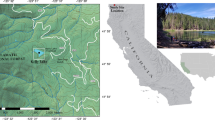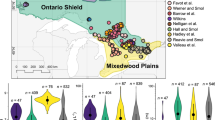Abstract
Two new methods for inferring pH from diatoms are presented. Both are based on the observation that the relationships between diatom taxa and pH are often unimodal. The first method is maximum likelihood calibration based on Gaussian logit response curves of taxa against pH. The second is weighted averaging. In a lake with a particular pH, taxa with an optimum close to the lake pH will be most abundant, so an intuitively reasonable estimate of the lake pH is to take a weighted average of the pH optima of the species present.
Optima and tolerances of diatom taxa were estimated from contemporary pH and proportional diatom counts in littoral zone samples from 97 pristine soft water lakes and pools in Western Europe. The optima showed a strong relation with Hustedt's pH preference groups. The two new methods were then compared with existing calibration methods on the basis of differences between inferred and observed pH in a test set of 62 additional samples taken between 1918 and 1983. The methods were ranked in order of performance as follows (between brackets the standard error of inferred pH in pH units); maximum likelihood (0.63) > weighted averaging (0.71) = multiple regression using pH groups (0.71) = the Gasse & Tekaia method (0.71) > Renberg & Hellberg's Index B (0.83) » multiple regression using taxa (2.2). The standard errors are larger than those usually obtained from surface sediment samples. The relatively large standard may be due to seasonal variation and to the effects of other factors such as humus content. The maximum likelihood method is statistically rigorous and can in principle be extended to allow for additional environmental factors. It is computer intensive however. The weighted averaging approach is a good approximation to the maximum likelihood method and is recommended as a practical and robust alternative.
Similar content being viewed by others
References
Alvey, N. C., N. Galwey & P. Lane, 1982. An introduction to GENSTAT. Academic Press, London, 152 pp.
Bartlein, P. J. & T. III Webb, 1985. Mean July temperature at 6000 yr B.P. in Eastern North America: regression equations from fossil-pollen data. Syllogeus 55: 301–342.
Battarbee, R. W., 1984. Diatom analysis and the acidification of lakes. Phil. Trans. r. Soc., London 305: 451–477.
Battarbee, R. W. & D. F. Charles, 1986. Diatom-based pH-reconstruction of acid lakes in Europe and North America. Wat. Air and Soil Pollut 30: 347–354.
Battarbee, R. W., J. P. Smol & J. Meriläinen, 1986. Diatoms as indicators of pH: an historical review. In J. P. Smol, R. W. Battarbee, R. B. Davis & J. Merilainen (eds), Diatoms and lake acidity. Junk, Dordrecht. Developments in Hydrobiology 29: 6–14
Berge, F., 1976. Diatoms and pH in some rivers and lakes in Agder and Telemark (Norway). A comparison between the years 1949 and 1975. Internal Report 18/76. SNSF-Project, Oslo-Ås, 36 pp. (in Norwegian)
Blakar, I. A. & T. Digernes, 1984. Evaluation of acidification based on former colorimetric determination of pH: the effect of indicators on pH in poorly buffered water. Verb. int. Ver. theor. and angew. Limnol. 22: 679–685.
Brown, P. J., 1982. Multivariate calibration. J. Roy. Statist. Soc. Ser. B 44: 287–321.
Charles, D. F., 1985. Relationships between surface sediment diatom assemblages and lakewater characteristics in Adirondack lakes. Ecology 66: 994–1011.
Davis, R. B., 1987. Paleolinmological diatom studies of acidification of lakes by acid rain: an application of Quaternary science. Quater. Sci. Rev. 6: 147–163.
Davis, R. B. & D. S. Anderson, 1985. Methods of pH calibration of sedimentary diatom remains for reconstructing history of pH in lakes. Hydrobiologia 120: 69–87.
Davis, R. B. & J. P. Smol, 1986. The use of sedimentary remains of siliceous algae for inferring past chemistry of lake waters — problems, potentials and research needs. In J. P. Smol, R. W. Battarbee, R. B. Davis & J. Meriläinen (eds), Diatoms and lake acidity. Junk, Dordrecht. Developments in Hydrobiology 29: 291–300
Dixit, S. S., 1986. Diatom-inferred pH calibration of lakes near Wawa, Ontario. Can. J. Bot. 64: 1129–1133.
Dixit, S. S. & R. D. Evans, 1986. Spatial variability in sedimentary algal microfossils and its bearing on diatominferred pH reconstructions. Can. J. Fish. aquat. Sci. 43: 1836–1845.
Ellenberg, H., 1948. Unkrautgesellschaften als Mass für den Säuregrad, die Verdichtung und andere Eigenschaften des Ackerbodens. Ber. Landtech. 4: 130–146.
Ellenberg, H., 1979. Zeigerwerte der Gefässpflanzen Mitteleuropas. Scripta Geobotanica 9, Göttingen, 121 pp.
Flower, R. J., 1986. The relationship between surface sediment diatom assemblages and pH in 33 Galloway Lakes: some regression models for reconstructing pH and their application to sediment cores. Hydrobiologia 143: 93–103.
Gasse, F. & F. Tekaia, 1983. Transfer functions for estimating paleoecological conditions (pH) from East African diatoms. Hydrobiologia 103: 85–90.
Gauch, H. G. & R. H. Whittaker, 1972. Coenocline simulation. Ecology 53: 446–451.
Gause, G. F., 1930. Studies on the ecology of the Orthoptera. Ecology 11: 307–325.
Gifi, A., 1981. Nonlinear multivariate analysis. DSWO-press, Leiden, 451 pp.
Goff, F. G. & G. Cottam, 1967. Gradient analysis: the use of species and synthetic indices. Ecology 48: 793–806.
Haines, T. A., J. G. Akielaszek, S. A. Norton & R. B. Davis, 1983. Errors in pH measurement with colorimetric methods in low alkalinity waters. Hydrobiologia 107: 56–61.
Hesse, R., 1924. Tiergeographie auf ökologischer Grundlage. Verlag von Gustav Fisher, Jena, 613 pp.
Howe, S. E. & T. III Webb, 1983. Calibrating pollen data in climatic terms: improving the methods. Quater. Sci. Rev. 2: 17–51.
Hustedt, F., 1939. Systematische und ökologische Untersuchungen über die Diatomeenflora von Java, Bali and Sumatra. Arch. Hydrobiol./Suppl. 16: 274–394.
Imbrie, J. & N. G. Kipp, 1971. A new micropaleontological method for quantitative paleoclimatology: application to a late Pleistocene Caribbean core. In K. K. Turekian (ed.): The late Cenozoic glacial ages. Yale University Press, New Haven: 77–181.
Jones, V. J. & R. J. Flower, 1986. Spatial and temporal variability in periphytic diatom communities: Palaeoecological significance in an acidified lake. In J. P. Smol, R. W. Battarbee, R. B. Davis & J. Meriläinen (eds), Diatoms and lake acidity. Junk, Dordrecht, Developments in Hydrobiology 29: 87–94
Jørgensen, B., 1983. Maximum likelihood estimation and large-sample inference for generalized linear and nonlinear regression models. Biometrika 70: 19–28.
Kelly, C. A., J. W. M. Rudd, A. Furutani & D. W. Schindler, 1984. Effects of lake acidification on rates of organic matter decomposition in sediments. Limnol. Oceanogr. 29: 687–694.
McCullagh, P. & J. A. Nelder, 1983. Generalized linear models. Chapman and Hall, London, 261 pp.
Montgomery, D. C. & E. A. Peck, 1982. Introduction to linear regression analysis. J. Wiley & Sons, NY, 504 pp.
Oehlert, G. W., 1986. Interval estimates for diatom inferred lake pH histories. Techn. report 469, School of Statistics, University of Minnesota, Minnesota.
Pantle, R. & H. Buck, 1955. Die biologische Ueberwachung der Gewässer und die Darstellung der Ergebnisse. Gasund Wasserfach 96: 604.
Renberg, I. & T. Hellberg, 1982. The pH history of lakes in southwestern Sweden as calculated from the subfossil diatom flora of the sediments. Ambio 11: 30–33.
Roux, M., 1979. Estimation des paléoclimats d'après l'écologie des foraminifères. Cah. Anal. Données 4: 61–79.
Salden, N., 1978. Beiträge zur Ökologie der Diatomeen (Bacillariophyceae) des Süsswassers. Decheniana, Beih. (Bonn) 22: 1–238.
Shelford, V. E., 1911. Ecological succession: stream fishes and the method of physiographic analysis. Biol. Bull. (Woods Hole) 21: 9–34.
Sládeček, V., 1986. Diatoms as indicators of organic pollution. Acta hydrochim. hydrobiol. 14: 555–566.
Steinberg, C., K. Arzet & D. Krause-Dellin, 1984. Gewässer-versauerung in der Bundesrepublik Deutschland im Lichte paläolimnologischer Studien. Naturwissenschaften 71: 631–634.
Stoermer, E. F. & T. B. Ladewski, 1976. Apparent optimal temperatures for the occurrence of some common phytoplankton species in southern Lake Michigan. Great Lakes Research Division, publication 18, the University of Michigan, Ann Arbor.
Taylor, M. C., H. C. Duthie & S. M. Smith, 1986. Surficial diatom assemblages — limnological relationships in Canadian Shield lakes. Poster, presented at the Ninth International Symposium on Living and Fossil Diatoms, Bristol. 24–30 August 1986.
Ter Braak, C. J. F., 1985. Correspondence analysis of incidence and abundance data: properties in terms of a unimodal reponse model. Biometrics 41: 859–873.
Ter Braak, C. J. F., 1986. Canonical correspondence analysis: a new eigenvector technique for multivariate direct gradient analysis. Ecology 67: 1167–1179.
Ter Braak, C. J. F., 1987a. Calibration. In R. H. G. Jongman, C. J. F. ter Braak & O. F. R. van Tongeren (eds), Data analysis in community and landscape ecology. Pudoc, Wageningen: 78–90.
Ter Braak, C. J. F., 1987b. The analysis of vegetation-environment relationships by canonical correspondence analysis. Vegetatio 69: 69–77.
Ter Braak, C. J. F., 1987c. CANOCO — a FORTRAN program for canonical community ordination by [partial][detrended] [canonical] correspondence analysis, principal components analysis and redundancy analysis (version 2.1). TNO Institute of Applied Computer Science, Wageningen, 95 pp.
Ter Braak, C. J. F. & L. G. Barendregt, 1986. Weighted averaging of species indicator values: its efficiency in environmental calibration. Math. Biosci. 78: 57–72.
Ter Braak, C. J. F. & C. W. N. Looman, 1986. Weighted averaging, logistic regression and the Gaussian response model. Vegetatio 65: 3–11.
Thienemann, A., 1932. Limnologie. In R. Dittler, G. Joos, E. Korschelt, G. Linck, F. Oltmanns & K. Schaum (eds), Handbuch der Naturwissenschaften (2. Aufl.), 6. Band. Fischer, Jena: 434–475.
Van Dam, H., 1984. A guide to the literature for the identification of freshwater diatoms in The Netherlands. Hydrobiol. Bull. 18: 11–16.
Van Dam, H. & K. Beljaars, 1984. Nachweis von Versauerung in West-Europäischen kalkarmen stehenden Gewässern durch Vergleich von alten and rezenten Kieselalgenproben. In J. Wieting, B. Lenhart, C. Steinberg, A. Hamm & R. Schoen (eds), Gewässerversauerung in der Bundesrepublik Deutschland. Umweltbundesamt/Schmidt, Berlin. Materialien 1: 184–188.
Van Dam, H. & H. Kooyman-van Blokland, 1978. Manmade changes in some Dutch moorland pools, as reflected by historical and recent data about diatoms and macrophytes. Int. Revue ges. Hydrobiol. 63: 587–607.
Van Dam, H., G. Suurmond & C. J. F. ter Braak, 1981. Impact of acidification on diatoms and chemistry of Dutch moorland pools. Hydrobiologia 35: 425–459.
Walker, I. R. & C. G. Paterson, 1986. Associations of diatoms in the surficial sediments of lakes and peat pools in Atlantic Canada. Hydrobiologia 134: 265–272.
Webb, T. III & D. R. Clark, 1977. Calibrating micropaleontological data in climatic terms: a critical review. Ann. N.Y. Acad. Sci. 288: 93–118.
Whittaker, R. H., S. A. Levin & R. B. Root, 1973. Niche, habitat and ecotope. Am. Nat. 107: 321–338.
Zelinka, M. & P. Marvan, 1961. Zur Präzisierung der biologischen Klassifikation der Reinheit fliessender Gewässer. Arch. Hydrobiol. 57: 389–407.
Author information
Authors and Affiliations
Rights and permissions
About this article
Cite this article
ter Braak, C.J.F., van Dame, H. Inferring pH from diatoms: a comparison of old and new calibration methods. Hydrobiologia 178, 209–223 (1989). https://doi.org/10.1007/BF00006028
Received:
Revised:
Accepted:
Issue Date:
DOI: https://doi.org/10.1007/BF00006028




